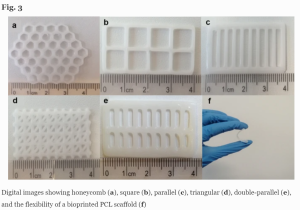Researchers designed a new cost-effective bandage treatment to treat diabetic foot ulcers. The scaffolding method, produced by 3D bioprinting, slowly released an antibiotic (levoflocixin) to the ulcer to promote healing.

Diabetic foot ulcers (DFUs) affect approximately 25 percent of people with diabetes. Over 50 percent of DFUs are already infected when they are identified, and over 70 percent of cases result in amputations.
Recent research has focused on drug-loaded scaffolds to treat DFUs. The scaffold structure is a novel carrier for cell and drug delivery that enhances wound healing.
In the latest study, 3D-bioprinted scaffolds with different designs were fabricated for the delivery of the antibiotic to DFUs. The scaffold technique provided sustained drug release for four weeks. The proof-of-concept study demonstrated the potential of bioprinting technologies for the treatment of DFU, the authors wrote.
“These scaffolds are like windows that enable doctors to monitor the healing constantly. This avoids needing to remove them constantly, which can provoke infection and delay the healing process,” said Dimitrios Lamprou, PhD, a professor of biofabrication and advanced manufacturing at Queen’s University Belfast School of Pharmacy and corresponding author of the study.
“The ‘frame’ has an antibiotic that helps to ‘kill’ the bacteria infection, and the ‘glass’ that can be prepared by collagen/sodium alginate can contain a growth factor to encourage cell growth. The scaffold has two molecular layers that both play an important role in healing the wound,” he said.
“Using bioprinting technology, we have developed a scaffold with suitable mechanical properties to treat the wound, which can be easily modified to the size of the wound. This provides a low-cost alternative to current DFU treatments, which could revolutionize DFU treatment, improving patient outcomes while reducing the economic burden caused by rapidly increasing patient demand as the number of people with diabetes continues to increase every year,” said Katie Glover, a PhD student from the Queen’s School of Pharmacy and lead author of the study.
Editor’s note: This story was adapted from materials provided by Queen’s University Belfast.
The open-access study, “3D bioprinted scaffolds for diabetic wound-healing applications,” was published in Springer Link.




